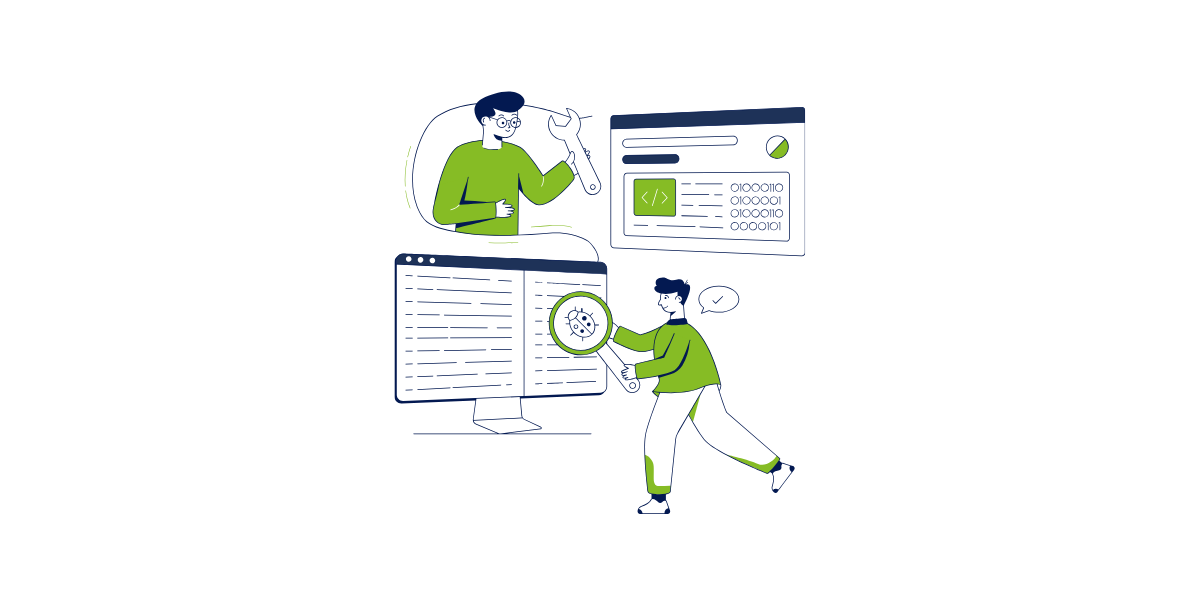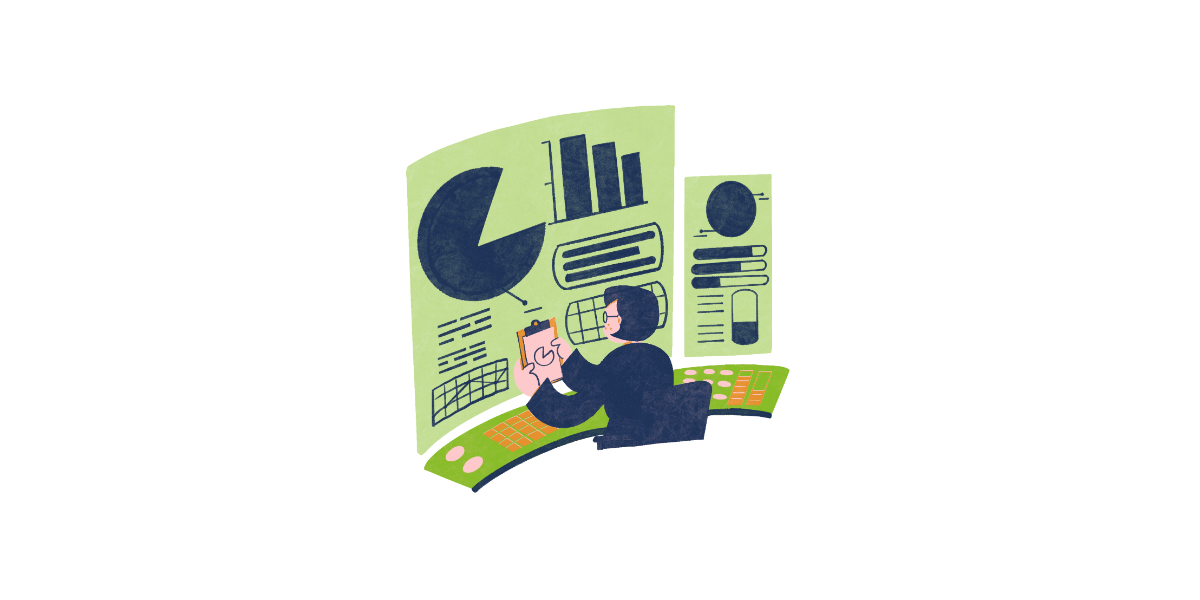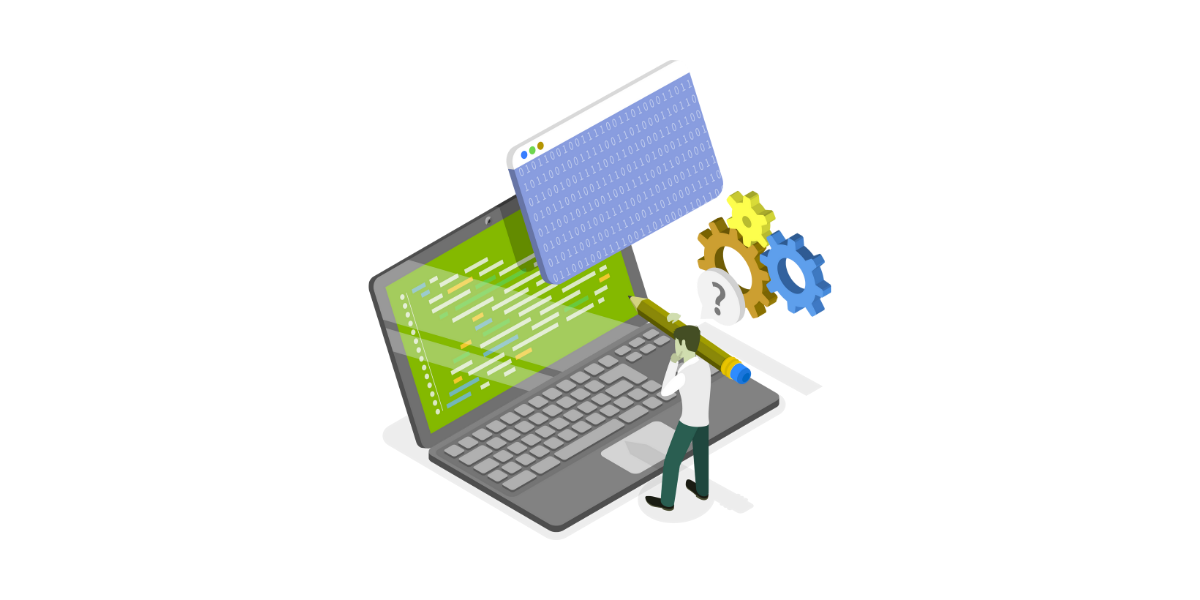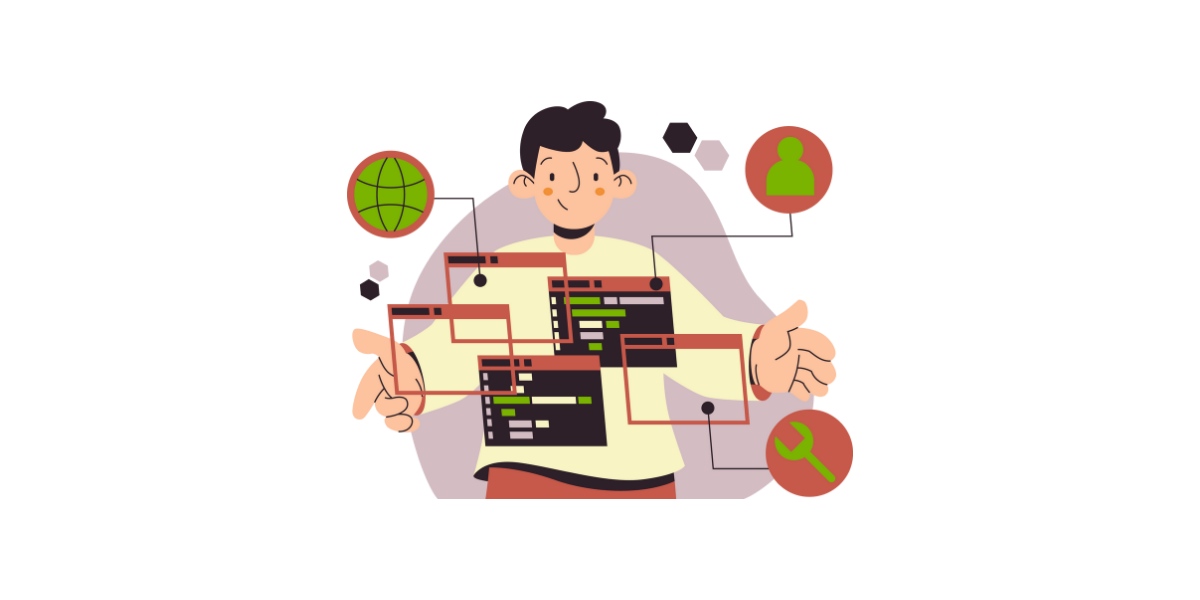
Software maintenance: How do I ensure the functionality of my systems?
Imagine you start your computer in the morning, open your software - and everything runs smoothly. No error messages, no unexpected failures, no "We have to update the system first" blockers. Sounds good, right?
Unfortunately, everyday life often looks different: Systems slow down, updates pile up, new security vulnerabilities appear - and at some point the moment comes when "nothing works". This is exactly when it becomes clear how important continuous software maintenance is.
Regular software maintenance not only prevents downtime, but also ensures the long-term efficiency and performance of your systems.
In this article, you will learn why software maintenance is not simply "optional", but crucial to ensuring that your applications remain reliable, secure and efficient. You will get a clear overview of which tasks are part of maintenance - and how we can support you as an experienced partner.

What is software maintenance?
Software maintenance refers to all measures that are carried out after the introduction of software in order to ensure its long-term functionality and maintain software quality throughout its entire life cycle. This includes, among other things
Elimination of errors
Improving performance, stability or other product features
Adaptations to changed technical or functional conditions
In Germany, the term is used even more precisely: Software maintenance includes all measures that maintain the operation and functionality of IT processes and software in use. This also includes the further development of software so that it fits the existing or new IT infrastructure. Maintenance also includes the targeted adaptation and optimization of specific attributes of the software product in order to increase its performance and efficiency.
In a broader sense, software maintenance can also include support services such as accompanying consulting, documentation or quality assurance. Maintenance concerns both individual software products and complex product landscapes that are used in companies.
The aim is to ensure the operational reliability, stability and future viability of the software. We at FIDA have been supporting companies for over 30 years with suitable maintenance and services to ensure that our customers' systems can be used reliably in the long term.
Why is regular software maintenance important?
The introduction of new software is a significant step for any company and involves considerable effort - from design and development to technical implementation and operation. However, even mature software does not remain permanently functional.
Technologies, technical requirements and market conditions are constantly evolving. To ensure that software remains reliable and usable in the long term, it must be regularly monitored and maintained - a decisive advantage for companies, as this proactively prevents disruptions and strengthens competitiveness. This is the only way to ensure that it keeps pace with new technical standards, security requirements and user expectations.

What types of software maintenance are there?
Various maintenance measures may become necessary during the life cycle of a software. Which of these are used depends on the occasion and the objective. Software often undergoes several or even all forms of maintenance over time.
There are basically four types of software maintenance:
Corrective software maintenance
Preventive software maintenance
Perfective software maintenance
Adaptive software maintenance
Depending on the type of software maintenance, specific maintenance techniques are used to ensure performance, troubleshooting and continuous improvement of the software.
1. corrective software maintenance
Corrective maintenance comprises measures to rectify errors and faults that affect the proper operation of the software, with troubleshooting as the central objective. The aim is to identify and solve problems as quickly as possible in order to avoid downtimes and restrictions.
Corrective measures are often triggered by error messages or user information. Ideally, however, anomalies should be identified and rectified before they become noticeable in daily use - for example through monitoring or automated reporting systems. This creates trust and ensures stable operation.
2. preventive software maintenance
Preventive maintenance focuses on the future. It is intended to prevent minor discrepancies from developing into major faults later on. This includes, for example, adjustments, optimizations, minor technical improvements or preparation for upcoming updates. Regular checks are also an important part of preventive maintenance in order to comply with legal requirements and ensure legal certainty.
The focus is on so-called latent errors - i.e. potential vulnerabilities that currently have no impact but could lead to problems in the future. By acting early, the software remains stable and reliable in the long term.
3. perfecting software maintenance
New requirements, wishes and suggestions for improvement often arise after use in everyday life. The aim of perfecting maintenance is to continuously develop and optimize software - for example by adding new functions, improving user-friendliness or adapting it to changing needs.
Perfection ensures that software remains modern, needs-based and attractive for its users. Functions that are no longer used can be reduced or removed in order to keep the software lean and efficient.
4. adaptive software maintenance
This form of maintenance is required when framework conditions change - for example due to new technical standards, updates to operating systems, changes in hardware or due to legal requirements and compliance requirements. Adaptive maintenance measures are often necessary after the software has been delivered in order to be able to react flexibly to such changes.
The software is adapted so that it remains compatible and meets the latest technical and regulatory requirements. The aim is to ensure secure and smooth operation in a constantly changing IT environment.
One example of such changing framework conditions is the FiDA regulation, which will offer financial service providers and insurers exciting new opportunities.

How does the software maintenance process work?
The maintenance process usually follows a defined procedure that ensures that changes are planned, implemented and checked in a structured manner. Structured processes are crucial for the successful implementation of maintenance measures and the sustainable optimization of software functionality. The scope may vary depending on the type of maintenance and the agreed service or maintenance plan, but the basic steps remain similar.
The most important process steps are
Identification and prioritization
The first step is to determine which components of the software need to be adapted or maintained. This can be triggered by user feedback, monitoring results, technical analyses or new requirements. The urgency of implementation is then assessed.
Analysis
In this step, the impact of the planned change on the system is examined. This often includes an effort and cost estimate to assess whether and to what extent the implementation makes sense.
Conception and design
Based on the analysis, the necessary adjustments are specified both professionally and technically. The goal is a clear concept of how the change should be implemented.
Implementation
The planned changes are developed and integrated into the code. This is done by the responsible development team or by specialized maintenance and service staff.
Testing
Before the rollout, a comprehensive check is carried out to ensure that the change works as intended. Both the affected modules and their interaction with the overall system are tested.
Acceptance test
Before the final release, it is ensured that the adaptation meets the requirements. Users or key users are often involved in order to provide feedback on the range of functions, usability and stability.
Deployment
After successful testing, the change is transferred to the production environment. The software is updated and is available to users in the new version.

How costly is software maintenance?
In the life cycle of software, a large part of the total cost is spent on maintenance and further development after implementation. Our experience shows that, depending on the software, area of application and service level, between 15 % and 25 % of the total annual IT costs are attributable to software maintenance.
The costs can vary greatly: Efficient processes, clear documentation and an experienced maintenance team can significantly reduce costs, whereas a lack of maintainability or complex structures can quickly increase costs. Efficient maintenance also maximizes system uptime, as downtimes are minimized and system availability is increased.
How high your maintenance costs will be depends on the following factors, among others:
Type of software and its use (e.g. enterprise software with many application scenarios)
Susceptibility to errors and maintainability of the software
Duration of use and changes in the environment
Experience and specialization of the maintenance team
Professional maintenance contributes significantly to investment security, especially for business-critical applications. At the same time, it is a cost factor that should not be underestimated. This is why maintenance or service contracts (SLAs) are often concluded to clearly regulate services, response times and costs.
If attention is paid to good maintainability during development, costs can be reduced later on. In the case of more extensive systems, maintenance is usually carried out by a specialized team in a defined process. This ensures that adjustments are made in a structured, comprehensible and sustainable manner.

What are the costs of maintaining software?
Software maintenance is an essential part of the entire software lifecycle and can account for a significant proportion of the total costs, whereby the costs of software maintenance in particular must be considered as part of the maintenance costs. Depending on the type of application, complexity and useful life, maintenance expenses can tie up a large part of the budget.
The amount of maintenance costs depends on several factors. Different software products can cause very different maintenance costs, as they differ in terms of structure, range of functions and integration capability. The most important influencing factors include
Age of the software and technological basis: Older systems usually incur higher costs as technologies, programming languages and frameworks continue to evolve. The modernization or further development of older software can therefore be more costly.
Complexity and transparency of the code: The more difficult software is to understand or analyze, the longer it takes to identify errors and implement changes. A lack of documentation and confusing code structures further increase the effort involved.
Availability of specialist knowledge: If only a few developers know the software or the technology used has become rare, the effort involved in troubleshooting and implementing adjustments increases.
In order to reduce maintenance costs in the long term, important steps can be taken during development - for example through clean architecture, good documentation, clear code structures and consistent further development. Modern development approaches also help to make it easier to adapt and maintain software later on.
Maintenance should be planned as a fixed cost factor from the outset, both for new developments and when taking over existing systems. Without regular maintenance, software loses performance and security over time and, in the worst case, becomes unusable.

How can FIDA help to reduce maintenance costs?
Software maintenance does not automatically have to be expensive and unmanageable. FIDA helps you to keep costs predictable while ensuring the functionality of your systems. The benefits of efficient maintenance from us lie in the sustainable increase in system availability, the reduction of downtimes and the optimization of your IT infrastructure.
This includes, among other things:
Individual maintenance agreements (SLAs): You know from the outset what services are included, how quickly changes will be implemented and what costs you will incur.
Regular updates and upgrades: Forward-looking planning and continuous adjustments keep systems stable, modern and secure.
Prioritization according to relevance: Errors, security risks or necessary adjustments are dealt with in a targeted manner so that no unnecessary resources are wasted.
Efficient processes and experienced specialists: With standardized maintenance processes and expert knowledge, FIDA noticeably reduces the effort for you.
This means you can be sure that your software will run reliably in the long term - without maintenance breaking your budget. At the same time, your system remains flexible and future-proof so that you can react quickly to new requirements or technological changes - and benefit from the advantages of working in partnership with FIDA.

How do I ensure that my software can be maintained?
To ensure that software functions reliably in the long term, companies should develop a clear maintenance strategy. Maintenance and effective maintenance management are crucial for planning, controlling and documenting maintenance tasks in the long term. A well thought-out strategy reduces effort, costs and risks and ensures that adjustments can be implemented in a structured manner.
Important elements of such a strategy include
Documentation:
Up-to-date and complete documentation is essential. It describes how the code works, what solutions exist for known problems and what adaptations have already been made. Without documentation, even a simple upgrade becomes time-consuming and error-prone.
Quality assurance:
Quality assurance is not just a step before the first release of the software, but should ideally be part of the development process from the very beginning. Early testing and continuous reviews help to identify potential errors before they become major problems and form the basis for subsequent maintenance work.
Process standardization:
Recurring maintenance tasks should be clearly defined and standardized. This allows changes to be carried out efficiently, responsibilities are clearly defined and the software remains stable in the long term.
Proactive planning:
Maintenance measures should not only be carried out when acute problems arise. Proactive planning - e.g. regular updates, monitoring and preventive adjustments - can avoid downtimes and extend the service life of the software.
With a consistent maintenance strategy, you can ensure that your software remains stable, secure and future-proof - and avoid unnecessary costs. FIDA can support you in implementing these strategies and setting up a continuous maintenance process.

Conclusion - software maintenance is a must!
Software maintenance is not an optional step, but a central component of the software lifecycle. It ensures that systems remain reliable, secure and future-proof - regardless of their age, complexity or the technology used.
A well thought-out maintenance strategy includes clear processes, regular checks, proactive adjustments and solid documentation. Particularly efficient maintenance processes are crucial for standardizing software maintenance, ensuring operational reliability and implementing adjustments efficiently. This allows errors to be detected at an early stage, adjustments to be implemented efficiently and costs to be kept predictable.
With FIDA's support, you benefit from tried-and-tested maintenance processes, experienced specialists and individual service agreements. This ensures that your software remains functional in the long term and you can concentrate on your core business without having to worry about technical pitfalls.
FAQ - Frequently asked questions about software maintenance
Software changes over time - due to new requirements, updates or security requirements. Without maintenance, the software can fail, security risks increase and usability decreases.
There are four main types:
Corrective maintenance: rectifying faults
Preventive maintenance: Preventing future problems
Perfective maintenance: improving and extending functions
Adaptive maintenance: adapting to new technologies, operating systems or regulations
The costs depend on the age, complexity and area of application of the software. The annual maintenance costs are usually 15-25% of the total IT costs, depending on the SLAs and scope of service.
Both are possible. External partners like us at FIDA offer standardized processes, experienced specialists and clear service agreements, which means that effort and costs remain predictable.
Clear and up-to-date documentation
Quality assurance right from the start
Standardized processes
Proactive planning and regular updates
